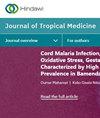Larvicidal, Ovicidal, and Repellent Activities of Leucas stachydiformis (Hochst. ex Benth.) Briq Essential Oil against Anopheles arabiensis
IF 2.1
4区 医学
Q3 PUBLIC, ENVIRONMENTAL & OCCUPATIONAL HEALTH
引用次数: 0
Abstract
Larvicidal, ovicidal, and repellent activities of the essential oil extracted by hydrodistillation from the leaves of the endemic Ethiopian plant Leucas stachydiformis (Hochst. ex Benth.) Briq were investigated against Anopheles arabiensis, the dominant malaria vector species in Ethiopia with the objective of searching for a plant-based malaria vector control strategy from medicinal plants. The larvicidal effect was tested against the fourth instar An. arabiensis wild larvae whilst freshly laid ova of An. arabiensis were used to determine the ovicidal activity of the essential oil at concentrations ranging from 6.25 to 400 ppm. Concentrations of 41.6–366.7 µg/cm2 were used to evaluate the repellent activity of the essential oil on 3–5 days old adult female An. arabiensis. The oil composition of L. stachydiformis was also analyzed using GC-MS. The study revealed that the oil possesses the highest larvicidal activity at 400 ppm and 200 ppm after 24 h and 48 h of treatment. LC50 values for the fourth larval instar after 24 h and 48 h of treatment were 43.4 ppm and 34.2 ppm, respectively. After 72 h of exposure, the oil displayed 100% ovicidal activity at 400 ppm with an IH50 value of 32.2 ppm. In the repellency test, at concentrations of 366.7, 133.3, and 41.6 µg/cm2, the oil gave a total percentage protection of 67.9 ± 4.2%, 37.2 ± 2.8%, and 32 ± 2.2%, respectively, for 4 h. The highest concentration (366.7 µg/cm2) gave 100% protection up to 90 min. GC-MS analysis of the oil revealed the presence of 24 compounds representing 90.34% of the total oil with caryophyllene oxide, germacrene D, and trans-caryophyllene constituting more than 50% of its components. Results of the present study suggest that the essential oil of L. stachydiformis has the potential to be used for the control of An. arabiensis mosquitoes.Leucas stachydiformis (Hochst. ex Benth.) Briq 精油对阿拉伯按蚊的杀幼虫、杀卵和驱虫活性
研究了从埃塞俄比亚特有植物 Leucas stachydiformis (Hochst. ex Benth.) Briq 的叶子中通过水蒸馏提取的精油对埃塞俄比亚主要疟疾病媒物种阿拉伯按蚊(Anopheles arabiensis)的杀幼虫、杀卵和驱虫活性,目的是从药用植物中寻找一种基于植物的疟疾病媒控制策略。对阿拉伯疟蚊第四龄野生幼虫的杀幼虫效果进行了测试,同时用刚产卵的阿拉伯疟蚊幼虫来确定精油在 6.25 至 400 ppm 浓度范围内的杀卵活性。用 41.6-366.7 µg/cm2 的浓度来评估精油对 3-5 天大的成年雌性阿拉伯蚂蚁的驱避活性。此外,还使用气相色谱-质谱分析了 L. stachydiformis 的精油成分。研究表明,在处理 24 小时和 48 小时后,精油在 400 ppm 和 200 ppm 的浓度下具有最高的杀幼虫活性。处理 24 小时和 48 小时后,第四龄幼虫的 LC50 值分别为 43.4 ppm 和 34.2 ppm。接触 72 小时后,在浓度为百万分之 400 时,该油显示出 100% 的杀卵活性,IH50 值为百万分之 32.2。在驱避试验中,浓度分别为 366.7、133.3 和 41.6 µg/cm2 的精油在 4 小时内的总保护率分别为 67.9 ± 4.2%、37.2 ± 2.8% 和 32 ± 2.2%。 最高浓度(366.7 µg/cm2)可在 90 分钟内提供 100% 的保护。对油的气相色谱-质谱分析显示,油中含有 24 种化合物,占油总量的 90.34%,其中氧化叶黄素、胚芽烯 D 和反式叶黄素占其成分的 50%以上。本研究的结果表明,L. stachydiformis 的精油具有用于控制阿拉伯蚊子的潜力。
本文章由计算机程序翻译,如有差异,请以英文原文为准。
求助全文
约1分钟内获得全文
求助全文
来源期刊

Journal of Tropical Medicine
Immunology and Microbiology-Parasitology
CiteScore
3.90
自引率
4.50%
发文量
0
审稿时长
14 weeks
期刊介绍:
Journal of Tropical Medicine is a peer-reviewed, Open Access journal that publishes original research articles, review articles, and clinical studies on all aspects of tropical diseases. Articles on the pathology, diagnosis, and treatment of tropical diseases, parasites and their hosts, epidemiology, and public health issues will be considered. Journal of Tropical Medicine aims to facilitate the communication of advances addressing global health and mortality relating to tropical diseases.
 求助内容:
求助内容: 应助结果提醒方式:
应助结果提醒方式:


